A&A 435, 799-810 (2005)
DOI: 10.1051/0004-6361:20041520
M. Tajer1,2 - G. Trinchieri1 - A. Wolter1 - S. Campana1 - A. Moretti1 - G. Tagliaferri1
1 -
INAF - Osservatorio Astronomico di Brera, via Brera 28, 20121
Milano, Italy
2 -
Università di Milano - Bicocca, Dipartimento di Fisica, P.za della Scienza 3,
20126 Milano, Italy
Received 23 June 2004 / Accepted 16 December 2004
Abstract
We obtained a sample of 143 normal galaxies with X-ray luminosity in the
range
1038-1043 erg s-1 from the cross-correlation of the
ROSAT HRI Brera Multi-scale Wavelet (BMW-HRI) Catalogue
with the Lyon-Meudon Extragalactic Database (LEDA). We find
that the average X-ray properties of this sample are in good
agreement with those of other samples of galaxies in the
literature. We selected a complete flux limited
serendipitous sample of 32 galaxies from which we
derived the
![]() distribution of normal galaxies in the
flux range
distribution of normal galaxies in the
flux range
![]() erg cm-2 s-1. The resulting
distribution is consistent with the Euclidean -1.5 slope.
Comparisons with other samples, such as the Extended Medium
Sensitivity Survey, the ROSAT All Sky Survey, the XMM-Newton/2dF
survey, and the Chandra Deep Field Survey indicate that
the
erg cm-2 s-1. The resulting
distribution is consistent with the Euclidean -1.5 slope.
Comparisons with other samples, such as the Extended Medium
Sensitivity Survey, the ROSAT All Sky Survey, the XMM-Newton/2dF
survey, and the Chandra Deep Field Survey indicate that
the
![]() distribution of normal galaxies is consistent
with a Euclidean slope over a flux range of about 6 decades.
distribution of normal galaxies is consistent
with a Euclidean slope over a flux range of about 6 decades.
Key words: X-ray: galaxies - galaxies: general - surveys
Elliptical galaxies were found to retain large amounts (
108 -1011 ![]() )
of hot gas (
)
of hot gas (
![]() K) whose thermal
emission dominates their X-ray luminosities, while in normal spirals the
integrated contribution of the evolved stellar sources, such as
supernova remnants and X-ray binaries, is generally the dominant component
(see Kim et al. 1992; Fabbiano et al. 1992; Fabbiano 1989). Extended
emission from a hot, gaseous component in spiral galaxies was detected
only in some cases (Vogler & Pietsch 1996; Trinchieri et al. 1988; Fabbiano & Trinchieri 1987), or associated with starburst activity.
K) whose thermal
emission dominates their X-ray luminosities, while in normal spirals the
integrated contribution of the evolved stellar sources, such as
supernova remnants and X-ray binaries, is generally the dominant component
(see Kim et al. 1992; Fabbiano et al. 1992; Fabbiano 1989). Extended
emission from a hot, gaseous component in spiral galaxies was detected
only in some cases (Vogler & Pietsch 1996; Trinchieri et al. 1988; Fabbiano & Trinchieri 1987), or associated with starburst activity.
Subsequent observations of individual sources made by ROSAT and ASCA confirmed most of the Einstein results and added interesting information on the X-ray properties of normal galaxies in the local universe (see among others Read et al. 1997; Brown & Bregman 1998; Beuing et al. 1999; Roberts & Warwick 2000).
With the launch of XMM-Newton and Chandra,
the study of the X-ray properties of "normal'' galaxies at
intermediate (
![]() )
or cosmological distances (Hornschemeier et al. 2002; Brandt et al. 2001; Georgakakis et al. 2004a; Norman et al. 2004; Georgakakis et al. 2004b; Hornschemeier et al. 2003; Georgakakis et al. 2003) was made possible, thanks to
significantly
improved sensitivity and spatial and spectral resolution of the
instruments. In spite of the large number of papers, however, a truly complete
sample of X-ray emitting normal galaxies in the local universe with a significant
number of objects has not been properly discussed in the literature so far.
Georgakakis et al. (2003) gave galaxy number density at
)
or cosmological distances (Hornschemeier et al. 2002; Brandt et al. 2001; Georgakakis et al. 2004a; Norman et al. 2004; Georgakakis et al. 2004b; Hornschemeier et al. 2003; Georgakakis et al. 2003) was made possible, thanks to
significantly
improved sensitivity and spatial and spectral resolution of the
instruments. In spite of the large number of papers, however, a truly complete
sample of X-ray emitting normal galaxies in the local universe with a significant
number of objects has not been properly discussed in the literature so far.
Georgakakis et al. (2003) gave galaxy number density at
![]() erg cm-2 s-1 from stacking analysis, while Georgakakis et al. (2004a) presented a sample of 26 X-ray sources detected in an area of
erg cm-2 s-1 from stacking analysis, while Georgakakis et al. (2004a) presented a sample of 26 X-ray sources detected in an area of ![]() 2.5 deg-2, of which only 2 were however classified as normal galaxies.
Georgakakis et al. (2004b) only recently presented a larger sample of 11
normal galaxies detected in an area of
2.5 deg-2, of which only 2 were however classified as normal galaxies.
Georgakakis et al. (2004b) only recently presented a larger sample of 11
normal galaxies detected in an area of ![]() 4.5 deg-2.
4.5 deg-2.
Two other samples of "normal'' galaxies are available in the literature, selected in the Chandra Deep Fields (Norman et al. 2004; Hornschemeier et al. 2003). However their median redshifts (z = 0.297, Hornschemeier et al. 2003; and z = 0 to z = 1.3, Norman et al. 2004) indicates that they should not be considered as "local''.
The large database provided by ROSAT has been exploited only marginally to derive unbiased and complete sample of galaxies. Zimmermann et al. (2001) selected a sample of candidate normal galaxies from the ROSAT All Sky Survey (RASS) Bright Source Catalogue (Voges et al. 1999) above a flux limit of about 10-12 erg cm-2 s-1 ( 0.1 - 2.4 keV band). A few samples were derived from the ROSAT Position Sensitive Proportional Counter (PSPC) pointed observations, such as the WGA (White et al. 1994) and the ROSPSPC (ROSAT team 2001), and a new catalogue of galaxies is in progress (G. Peres, private communication). Here we exploited the potential of the Brera Multi-scale Wavelet (BMW-HRI) catalogue (Panzera et al. 2003) to extract a sample of normal galaxies, as we discuss in the next sections. While the PSPC is probably more efficient at detecting faint and extended sources such as galaxies, the sharp core of the HRI point spread function allows us to detect sources in more crowded fields and to measure the extent of bright, small-size sources, providing a good complement to the PSPC data.
Created in 1983 at Lyon Observatory, LEDA![]() was the first
database of extragalactic objects and it is continuously updated. It
gives a free access to the main astrophysical parameters (coordinates,
morphological type, diameter and axis ratio, apparent magnitudes and
colors, radial velocity, surface brightness, etc.) for about 106 galaxies over the whole sky. The completeness in apparent B-magnitude
is satisfied up to
mB = 15.5 (see Paturel et al. 1997).
was the first
database of extragalactic objects and it is continuously updated. It
gives a free access to the main astrophysical parameters (coordinates,
morphological type, diameter and axis ratio, apparent magnitudes and
colors, radial velocity, surface brightness, etc.) for about 106 galaxies over the whole sky. The completeness in apparent B-magnitude
is satisfied up to
mB = 15.5 (see Paturel et al. 1997).
![\begin{figure}
\par\includegraphics[width=8.8cm,clip]{1520fig1.ps}
\end{figure}](/articles/aa/full/2005/21/aa1520/Timg22.gif) |
Figure 1:
Displacement between optical and X-ray positions for point-like sources in
the total sample. The solid circle refers to thecross-correlation radius of
20
|
| Open with DEXTER | |
To obtain a representative sample of galaxies we started from the BMW-HRI catalogue and included only serendipitous detections, avoiding
the targets. We chose a 3![]() radius to define the typical region
of the target, and selected only sources at off-axis angles
radius to define the typical region
of the target, and selected only sources at off-axis angles
![]()
![]() .
In spite of this location, we had to exclude 12 additional sources that were targets of the observations. We then
cross-correlated the positions of the X-ray sources in the BMW-HRI
catalogue with those of galaxies present in the LEDA database version
of 1999 with a tolerance of 20
.
In spite of this location, we had to exclude 12 additional sources that were targets of the observations. We then
cross-correlated the positions of the X-ray sources in the BMW-HRI
catalogue with those of galaxies present in the LEDA database version
of 1999 with a tolerance of 20
![]() ,
which should be a reasonable
guess to detect extended objects like galaxies and to avoid most of
spurious coincidences. This criterium is not appropriate for very
extended galaxies (e.g. M 31 or M 33), where a large number of
sources are detected at distances significantly larger than our
tolerance radius. Therefore we could be selecting against
large galaxies, if there is no source within a distance of
,
which should be a reasonable
guess to detect extended objects like galaxies and to avoid most of
spurious coincidences. This criterium is not appropriate for very
extended galaxies (e.g. M 31 or M 33), where a large number of
sources are detected at distances significantly larger than our
tolerance radius. Therefore we could be selecting against
large galaxies, if there is no source within a distance of
![]() 20
20
![]() from the nucleus. However, this should not be a
concern in this study, since the surface density of large
galaxies is small; in particular, in the LEDA catalog, the
density of galaxies with
D25 >3' is <
from the nucleus. However, this should not be a
concern in this study, since the surface density of large
galaxies is small; in particular, in the LEDA catalog, the
density of galaxies with
D25 >3' is <
![]() deg-2, which implies about <10 in the area we surveyed.
deg-2, which implies about <10 in the area we surveyed.
To check the goodness of our choice, we plotted
the relative shifts between optical and X-ray positions in Fig. 1.
We used only point-like X-ray sources because in extended sources the association
with a single optical object could be misleading (e.g. in groups and pairs).
About 90% of the identifications are within 13
![]() (represented by the
dashed circle in Fig. 1).
(represented by the
dashed circle in Fig. 1).
This is in good agreement with the HRI positional
uncertainty, since the best attitude solution guarantees that on average
known objects are detected within 10
![]() of their catalog position,
although with possible additional discrepancy mainly in declination
(see the ROSAT Handbook at http://heasarc.gsfc.nasa.gov/docs/rosat/ruh/handbook/handbook.html).
We verified that all X-ray sources with X-ray/optical off-set
>10
of their catalog position,
although with possible additional discrepancy mainly in declination
(see the ROSAT Handbook at http://heasarc.gsfc.nasa.gov/docs/rosat/ruh/handbook/handbook.html).
We verified that all X-ray sources with X-ray/optical off-set
>10
![]() are still within the galaxy (i.e. D25).
We concluded that the association of the X-ray sources with galaxies found
by the cross-correlation is sound on positional grounds.
are still within the galaxy (i.e. D25).
We concluded that the association of the X-ray sources with galaxies found
by the cross-correlation is sound on positional grounds.
The cross-correlation yielded 399 X-ray sources associated with 281
galaxies. Since constructed field-by-field, the BMW-HRI catalogue
contains multiple detections of the same source. Therefore we only had 283 distinct X-ray sources associated with galaxies![]() .
.
To check the results of the cross-correlation, we inspected HRI images for each source and obtained information from the NASA/IPAC Extragalactic Database (NED) to a) eliminate spurious coincidences [15 sources], b) eliminate AGNs [47 objects], and c) select clusters [57 objects].
These selection criteria yielded a total of 195 X-ray sources (including multiple detections) associated with 143 galaxies whose properties are listed in Table 1, which is available in electronic form. We show the first page here as an example. Col. (1) gives the BMW-HRI name of the source, Cols. (2) and (3) the position of the X-ray peak, Col. (4) the extension of the X-ray source (or "p'' if the source is point-like; asterisks label extended sources for which count rates have been estimated using ad hoc regions), Col. (5) the LEDA galaxy associated to the X-ray source, Col. (6) the name of the galaxy in other common catalogues (e.g. NGC), Col. (7) the morphological type, Col. (8) the distance of galaxy, Col. (9) the apparent B-magnitude corrected for galactic extinction, inclination and redshift effects (see Paturel et al. 1997), Col. (10) the HRI count rate with error, Col. (11) the flux with error, Col. (12) the logarithm of X-ray luminosity (count rates and fluxes have been recomputed with respect to values reported in the BMW-HRI catalogue; see Sect. 3 for details), and Col. (13) specifies whether the galaxy is in the complete subsample (c), in cluster (Cl) or in group (Gr).
Information about magnitudes and redshifts are from LEDA and NED except for 3 objects that we observed ourselves (see Sect. 5). We calculated distances from redshifts, assuming H0 = 50 km s-1 Mpc-1; when the heliocentric radial velocity of galaxy was less than 3000 km s-1, however, we used distances from Nearby Galaxy Catalogue (Tully 1988) corrected for H0 = 50 km s-1 Mpc-1.
One hundred and sixteen of the 143 galaxies have redshift and magnitude
(including our observations). Nineteen galaxies have mB and no z,
3 have z and no mB, and 5 have neither z nor mB. The redshift
distribution ranges from z = 0 from
![]() ,
but
,
but ![]()
![]() of
the galaxies have z < 0.07.
of
the galaxies have z < 0.07.
We also excluded objects at low galactic latitude (
![]() )
to avoid source confusion in the galactic plane and X-ray sources
with off-axis angle
)
to avoid source confusion in the galactic plane and X-ray sources
with off-axis angle
![]() to
match the circular HRI field of view used in the sky coverage computation
(see Sect. 7).
to
match the circular HRI field of view used in the sky coverage computation
(see Sect. 7).
The resulting sample of 96 objects is complete both in X-ray and
optical at the given limits. However, since galaxies are often in
agglomerates, some of them
are expected to be related to the targets
and therefore not be truly
serendipitous. We therefore excluded all sources known to be associated
with the target (e.g. galaxies in pairs, groups or clusters; 52 objects in all).
When an association was not documented (e.g. from
NED, LEDA) we conservatively excluded galaxies at the same redshift as
the target (12 objects).
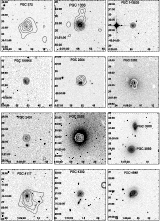 |
Figure 2:
First page of the figure available in electronic form. It presents
the
X-ray contours from smoothed X-ray images superimposed onto optical images.
Galaxies are generally at the center of the field. Smoothing is done with a
Gaussian function of
|
| Open with DEXTER | |
The complete, serendipitous sample of 32 galaxies thus obtained is given in
Table 3 and will be
used to calculate the
![]() distribution in the local universe (z < 0.07),
as will be described in detail in
Sect. 7.
distribution in the local universe (z < 0.07),
as will be described in detail in
Sect. 7.
Table 1: First page of table of the total sample, available in electronic form.
For point-like sources the counts were obtained in a circular region
centered at the peak of X-ray emission, with radius that includes about 90% of source counts according to the PSF. The PSF degrades as the
angular distance from the center of field increases, so we chose a
radius of r = 18
![]() for
for
![]()
![]() ,
r =25
,
r =25
![]() for
for
![]()
![]() and
r =40
and
r =40
![]() for
for
![]()
![]() ,
following Boese (2000). We
evaluated the background in an annulus concentric to the source radius
with radii depending on the off-axis.
When the source was particularly faint, we calculated count rates in a
circle of radius corresponding to a smaller fraction of the PSF, to
increase the signal-to-noise ratio. We then corrected the count rate
accordingly following Boese (2000).
,
following Boese (2000). We
evaluated the background in an annulus concentric to the source radius
with radii depending on the off-axis.
When the source was particularly faint, we calculated count rates in a
circle of radius corresponding to a smaller fraction of the PSF, to
increase the signal-to-noise ratio. We then corrected the count rate
accordingly following Boese (2000).
We then compared count rates obtained in this way with those reported in the BMW-HRI catalogue and found general agreement, except for some sources whose extension had been largely underestimated by the wavelet algorithm, as stated above. Indeed, our count rates would be equivalent to the "counted count rates'' reported in the catalogue, rather than those computed with the wavelet algorithm. In comparison with this quantity, we found a systematically higher count rate that is consistent with the larger PHA interval used (1 - 10 in our analysis and 2 - 9 in the BMW-HRI catalogue).
The resulting net count rates are given in Table 1, corrected for vignetting and lost counts due to the PSF (for point sources only).
To calculate luminosities, we used distances listed in Table 1. The corresponding range in ![]() is
1038 - 1043 erg s-1.
is
1038 - 1043 erg s-1.
X-ray contours are produced from images in the PHA range 1-10, smoothed using
a Gaussian function with
![]()
![]() for point-like sources
and with
for point-like sources
and with
![]()
![]() for extended sources.
for extended sources.
Table 2:
Galactic
![]() and corresponding unabsorbed flux in the band
0.1-2 keV for 1 count/s, assuming a thermal bremsstrahlung spectral model with
kT = 5 keV.
and corresponding unabsorbed flux in the band
0.1-2 keV for 1 count/s, assuming a thermal bremsstrahlung spectral model with
kT = 5 keV.
Table 3: Galactic column density (from Dickey & Lockman 1990), BMW count rates and fluxes for galaxies in the complete serendipitous sample, ordered by increasing flux.
![\begin{figure}
\par\includegraphics[width=8.2cm,clip]{1520fig3.ps}
\end{figure}](/articles/aa/full/2005/21/aa1520/Timg54.gif) |
Figure 3: X-ray-to-optical ratio distribution for the total sample. Both fluxes are in units of erg cm-2 s-1. |
| Open with DEXTER | |
The complete serendipitous sample of galaxies derived in Sect. 2.1 (listed in
Table 3) was used to calculate the integral flux distribution
(
![]() )
of normal galaxies with X-ray emission above the X-ray flux limit
of the BMW-HRI Catalogue
and B-magnitude
)
of normal galaxies with X-ray emission above the X-ray flux limit
of the BMW-HRI Catalogue
and B-magnitude ![]() 15.5.
15.5.
The sensitivity of the HRI instrument is not uniform over the entire field of view. Moreover the observing time is different for different fields so we calculated the area surveyed at any given flux (sky coverage).
In the BMW-HRI catalogue the published sky coverage was calculated by
means of simulations (see Panzera et al. 2003). In this work we
used a sky coverage calculated with the same procedure, but with
parameters that reflect our source selection criteria, including therefore only
fields with galactic
latitude
![]() .
We considered only an annular region with
.
We considered only an annular region with
![]()
![]() :
the lower limit accounts
for the target region; the upper limit is the largest radius within the field
of view of the detector in
the assumption of circular symmetry; and we assumed a bremsstrahlung
spectrum with kT = 5 keV plus the line of sight absorption.
:
the lower limit accounts
for the target region; the upper limit is the largest radius within the field
of view of the detector in
the assumption of circular symmetry; and we assumed a bremsstrahlung
spectrum with kT = 5 keV plus the line of sight absorption.
The resulting sky coverage is plotted in Fig. 4. The
maximum area is ![]() 314 deg2 and corresponds to fluxes above
314 deg2 and corresponds to fluxes above
![]() 10-12 erg cm-2 s-1. The surveyed area
is
10-12 erg cm-2 s-1. The surveyed area
is ![]() 196 deg2 at 10-13 erg cm-2 s-1 and
196 deg2 at 10-13 erg cm-2 s-1 and
![]() 3 deg2 at
3 deg2 at ![]()
![]() erg cm-2 s-1 (the lowest
flux for the galaxies in our sample).
erg cm-2 s-1 (the lowest
flux for the galaxies in our sample).
![\begin{figure}
\par\includegraphics[width=8.4cm,clip]{1520fig4.ps}
\end{figure}](/articles/aa/full/2005/21/aa1520/Timg58.gif) |
Figure 4:
Sky coverage for the fields at galactic latitude |
| Open with DEXTER | |
For consistency with the sky coverage calculation, fluxes given in Table 3 are derived from the original count rates estimated in the BMW-HRI catalogue, using the wavelet algorithm and PHA channels of HRI from 2 to 9, which are corrected for vignetting and PSF according to Campana et al. (1999) and computed for the energy band 0.5 - 2 keV, the BMW-HRI Catalogue standard.
The integral
![]() distribution of the sample is shown in Fig. 5 and covers two decades in flux, from
distribution of the sample is shown in Fig. 5 and covers two decades in flux, from ![]() 1.1 to
1.1 to
![]()
![]() erg cm-2 s-1. The overall distribution
could be
approximated with a slope of
erg cm-2 s-1. The overall distribution
could be
approximated with a slope of ![]() -1.1 (solid line in Fig. 5). However the Euclidean slope of -1.5 (dashed line)
is also consistent with the data: the excess of galaxies at the highest
fluxes is small and consistent within the limited statistics. Moreover,
at the lower fluxes, there could be some problems with incompleteness,
as we discuss below.
-1.1 (solid line in Fig. 5). However the Euclidean slope of -1.5 (dashed line)
is also consistent with the data: the excess of galaxies at the highest
fluxes is small and consistent within the limited statistics. Moreover,
at the lower fluxes, there could be some problems with incompleteness,
as we discuss below.
Before comparing our
![]() distribution with those of other
samples in the literature, we need to investigate the X-ray-to-optical ratio distribution of our complete sample more throughly.
We consider samples
derived from ROSAT and Einstein observations
that cover a flux range similar to ours;
samples derived from
XMM-Newton and
Chandra surveys, which cover a flux range significantly
fainter than ours, will be considered later, in the discussion
of the
distribution with those of other
samples in the literature, we need to investigate the X-ray-to-optical ratio distribution of our complete sample more throughly.
We consider samples
derived from ROSAT and Einstein observations
that cover a flux range similar to ours;
samples derived from
XMM-Newton and
Chandra surveys, which cover a flux range significantly
fainter than ours, will be considered later, in the discussion
of the
![]() (Sect. 7.2).
(Sect. 7.2).
The best available comparison could be with the sample of candidate normal galaxies found by Zimmermann et al. (2001) in the ROSAT All Sky Survey (RASS) and with the normal galaxies found in the Einstein Extended Medium Sensitivity Survey (EMSS; Gioia et al. 1990), both X-ray selected. An effective optically selected sample for comparison is the Einstein galaxy sample (Fabbiano et al. 1992; Shapley et al. 2001; Eskridge et al. 1995).
Zimmermann et al. (2001) made a correlation study of the RASS Bright
Source Catalogue (Voges et al. 1999) with the Catalogue of Principal
Galaxies (Paturel et al. 1989),
from which they selected a sample of 198 candidate galaxies,
i.e. X-ray sources whose optical counterpart was not designated as AGN in
the literature. These selection criteria are similar to ours, and the
Catalogue of Principal Galaxies is a preliminary version of the current
LEDA database, so the two samples can be easily compared; however
most of their sources have fluxes above 10-12 erg cm-2 s-1 (computed in the
0.1 - 2.4 keV band, assuming a
power law spectrum with photon index
![]() ).
).
![\begin{figure}
\par\includegraphics[width=8.6cm,clip]{1520fig5.ps}
\end{figure}](/articles/aa/full/2005/21/aa1520/Timg61.gif) |
Figure 5:
The integral
|
| Open with DEXTER | |
The EMSS was obtained from analysis of 1453 images of the imaging
proportional counter (IPC) on board the Einstein Observatory.
The survey covers an area of 778 deg2 at |b| > 20![]() with
limiting sensitivity ranging from
with
limiting sensitivity ranging from ![]()
![]() to
to ![]()
![]() erg cm-2 s-1 (
0.3 - 3.5 keV band). 835 serendipitous
sources were detected at or above the 4
erg cm-2 s-1 (
0.3 - 3.5 keV band). 835 serendipitous
sources were detected at or above the 4![]() level (see Gioia et al. 1990; Stocke et al. 1991). Among
these, 17 were identified as normal galaxies.
level (see Gioia et al. 1990; Stocke et al. 1991). Among
these, 17 were identified as normal galaxies.
The Einstein sample is the catalogue of normal galaxies observed by
the Einstein satellite, compiled by Fabbiano et al. (1992) and
reanalyzed by Eskridge et al. (1995, for early-type galaxies) and by
Shapley et al. (2001, for spiral galaxies); we no longer distinguish the
two samples here since early and late type galaxies are mixed in the BMW-HRI sample. We consider here only detections in the Einstein sample;
the exclusion of upper limits should not affect the results, since their
distribution is consistent with that of detections (see Fig. 5 in Shapley et al. 2001).
![\begin{figure}
\par\includegraphics[width=8.6cm,clip]{1520fig6.ps}
\end{figure}](/articles/aa/full/2005/21/aa1520/Timg64.gif) |
Figure 6:
B flux versus X-ray flux for our total sample
(solid triangles), for the Einstein
sample (empty circles), for the Zimmermann et al. (2001) sample galaxies
(asterisks), and for the EMSS galaxies (empty pentagons). Solid lines
correspond to log
|
| Open with DEXTER | |
In Fig. 6 we plot the distribution of ![]() and FB values from
all samples considered. For consistency with the values in Table 1,
all fluxes are converted to the 0.1 - 2 keV energy band, using a thermal
bremsstrahlung spectrum with temperature kT = 5 keV and
and FB values from
all samples considered. For consistency with the values in Table 1,
all fluxes are converted to the 0.1 - 2 keV energy band, using a thermal
bremsstrahlung spectrum with temperature kT = 5 keV and
![]() cm-2.
cm-2.
Figure 6 clearly indicates that galaxies belonging to different
samples populate different regions in the plot. Our sample (solid triangles)
has an X-ray flux range between 10-14 and 10-11 erg cm-2 s-1
and log (
![]() )
between -4 and 0 (see also Fig. 3). The bulk of
Einstein galaxies (empty circles) is typically at higher average fluxes
and at lower values of log (
)
between -4 and 0 (see also Fig. 3). The bulk of
Einstein galaxies (empty circles) is typically at higher average fluxes
and at lower values of log (
![]() (between -4 and -2) compared to our
distribution and to the X-ray selected
samples in general. This sample is the largest; it is effectively
optically selected and reasonably clean of contamination from AGN
(Shapley et al. 2001). However, since it is not complete, it might not
provide true distribution of the X-ray-to-optical ratios.
(between -4 and -2) compared to our
distribution and to the X-ray selected
samples in general. This sample is the largest; it is effectively
optically selected and reasonably clean of contamination from AGN
(Shapley et al. 2001). However, since it is not complete, it might not
provide true distribution of the X-ray-to-optical ratios.
The second largest sample is derived from Zimmermann et al. (2001), with an
additional flux limit
![]() erg cm-2 s-1 (for
completeness, see discussion below)
and an upper limit in luminosity at
erg cm-2 s-1 (for
completeness, see discussion below)
and an upper limit in luminosity at
![]() erg s-1, the highest
luminosity
in our complete sample, comparable to their limit to exclude potential
AGNs from the sample. The distribution of candidate galaxies in
Zimmermann et al. (2001) (asterisks) is significantly different from that of
the Einstein sample and extends at
erg s-1, the highest
luminosity
in our complete sample, comparable to their limit to exclude potential
AGNs from the sample. The distribution of candidate galaxies in
Zimmermann et al. (2001) (asterisks) is significantly different from that of
the Einstein sample and extends at
![]() .
The
.
The
![]() distribution for EMSS galaxies (empty pentagons) is at
intermediate values and more consistent with that of our sample.
distribution for EMSS galaxies (empty pentagons) is at
intermediate values and more consistent with that of our sample.
Also plotted in Fig. 6 is the optical flux limit applied to our
sample,
mB = 15.5. It is evident that excluding galaxies fainter than this
for the
![]() calculation has an effect that increases as flux decreases.
We attepted to quantify it in order to correct the curve for lost objects.
Unfortunately we could not properly estimate the correction
because none of the
galaxy samples available allows us to derive the true distribution of X-ray-to-optical ratios of normal galaxies. The EMSS should represent the
true
calculation has an effect that increases as flux decreases.
We attepted to quantify it in order to correct the curve for lost objects.
Unfortunately we could not properly estimate the correction
because none of the
galaxy samples available allows us to derive the true distribution of X-ray-to-optical ratios of normal galaxies. The EMSS should represent the
true
![]() FB distribution, but given the small number of galaxies
(17, of which only 15 have B-magnitude), statistical errors are large.
The difference in distribution of ratios between the two larger
samples in Fig. 6 suggests that they might be affected by
opposite biases; the Zimmermann et al. (2001) sample is likely to
contain unclassified AGNs, while the Einstein sample could
lose objects at the highest X-ray-to-optical ratios. If we use the
three samples to estimate how many galaxies are lost as a function of
X-ray flux, we find that corrections to the
FB distribution, but given the small number of galaxies
(17, of which only 15 have B-magnitude), statistical errors are large.
The difference in distribution of ratios between the two larger
samples in Fig. 6 suggests that they might be affected by
opposite biases; the Zimmermann et al. (2001) sample is likely to
contain unclassified AGNs, while the Einstein sample could
lose objects at the highest X-ray-to-optical ratios. If we use the
three samples to estimate how many galaxies are lost as a function of
X-ray flux, we find that corrections to the
![]() are
small and the recomputed curve is consistent with the Euclidean slope
in the observed flux range.
are
small and the recomputed curve is consistent with the Euclidean slope
in the observed flux range.
We also tried to estimate the correction by considering optically fainter galaxies. At mB = 16, LEDA is about 90% complete (see Fig. 7 in Paturel et al. 1997). If we include galaxies down to this flux limit, we only add 4 objects to our serendipitous sample, distributed over the whole range of X-ray fluxes; therefore, their inclusion influences only slightly the normalization, not the slope of the distribution.
We conclude that since the effects introduced by the
optical limit are small,
the
![]() we derive is consistent with the Euclidean slope.
we derive is consistent with the Euclidean slope.
![\begin{figure}
\par\includegraphics[width=8.5cm,clip]{1520fig7.ps}
\end{figure}](/articles/aa/full/2005/21/aa1520/Timg73.gif) |
Figure 7:
Comparison of the
|
| Open with DEXTER | |
Figure 7 shows the comparison between the
![]() derived above with several available from the literature.
All fluxes are recomputed in the 0.5 - 2 keV range that we use. We find
excellent agreement with other samples that cover similar or
brighter flux ranges than the present sample.
derived above with several available from the literature.
All fluxes are recomputed in the 0.5 - 2 keV range that we use. We find
excellent agreement with other samples that cover similar or
brighter flux ranges than the present sample.
The candidate galaxies (Zimmermann et al. 2001)
appear to connect smoothly with
the Euclidean extrapolation of the BMW-HRI
![]() above 10-12 erg cm-2 s-1.
We interpret the flattening observed in the
Zimmermann et al. (2001) data at lower fluxes
as a result of their selection criteria. In fact, they indicate a
above 10-12 erg cm-2 s-1.
We interpret the flattening observed in the
Zimmermann et al. (2001) data at lower fluxes
as a result of their selection criteria. In fact, they indicate a ![]() 90%
completeness for count rates
90%
completeness for count rates ![]() 0.1 count s-1, which converts to
a flux of
0.1 count s-1, which converts to
a flux of
![]() erg cm-2 s-1.
erg cm-2 s-1.
Although small, the EMSS is
a truly complete sample, since it is
serendipitously X-ray selected and ![]()
![]() identified
(Gioia et al. 1990; Stocke et al. 1991; Maccacaro et al. 1994).
The EMSS appears to be Euclidean and almost coincident with our curve for fluxes
above 10-13 erg cm-2 s-1.
identified
(Gioia et al. 1990; Stocke et al. 1991; Maccacaro et al. 1994).
The EMSS appears to be Euclidean and almost coincident with our curve for fluxes
above 10-13 erg cm-2 s-1.
We also extended the comparison to include samples at fainter fluxes.
Georgakakis et al. (2004a) compute the
![]() of sources in
the XMM-Newton/2dF survey, obtained with the EPIC instrument on board the
XMM-Newton satellite. This survey covers an area of about
2.5 deg2 to the flux limit
of sources in
the XMM-Newton/2dF survey, obtained with the EPIC instrument on board the
XMM-Newton satellite. This survey covers an area of about
2.5 deg2 to the flux limit ![]() 10-14 erg cm-2 s-1 in the
0.5 -8 keV band (or
10-14 erg cm-2 s-1 in the
0.5 -8 keV band (or
![]() erg cm-2 s-1).
They
find two "normal'' galaxies
in their sample, which implies a density of <1 source at
erg cm-2 s-1).
They
find two "normal'' galaxies
in their sample, which implies a density of <1 source at
![]() erg cm-2 s-1, lower than what we find.
erg cm-2 s-1, lower than what we find.
However, the sample of Georgakakis et al. (2004a) contains three
additional galaxies (at
![]() with
with
![]() erg s-1)
that the authors do not consider
because they might contain Low Luminosity AGNs (LLAGNs, see their Fig. 2).
Since we cannot exclude that our sample also contains a few LLAGNs (see above and Sect. 6),
we should consider these objects for better
comparison with our sample. With inclusion of these objects the
erg s-1)
that the authors do not consider
because they might contain Low Luminosity AGNs (LLAGNs, see their Fig. 2).
Since we cannot exclude that our sample also contains a few LLAGNs (see above and Sect. 6),
we should consider these objects for better
comparison with our sample. With inclusion of these objects the
![]() matches ours better.
matches ours better.
Also shown in Fig. 7 are the
constraints from the stacking analysis results of Georgakakis et al. (2003) at fainter fluxes, computed from optically selected galaxies at a mean
redshift of
![]() .
The point derived from the total sample considered is
in excellent agreement with our
.
The point derived from the total sample considered is
in excellent agreement with our
![]() .
.
Recently Georgakakis et al. (2004b) have presented a pilot
sample of normal galaxies serendipitously detected in XMM-Newton
public observations. They find 11 "normal'' galaxy candidates with luminosities
below 1042 erg s-1 over an area of ![]() 4.5 deg2. They find that the
4.5 deg2. They find that the
![]() derived from this sample
(plotted in Fig. 7) is again almost Euclidean in slope, although at a
smaller normalization than ours.
derived from this sample
(plotted in Fig. 7) is again almost Euclidean in slope, although at a
smaller normalization than ours.
We also plot the results from deeper surveys, using data from Hornschemeier et al. (2003), Norman et al. (2004) as reported by Ranalli et al. (2004), and Bauer et al. (2004) derived from the Chandra Deep Fields. All these relations fall close to, though generally below, the extrapolation from our sample. Different authors derive different slopes for their samples, but they are all consistent with the Euclidean one.
The lower normalizations found in these latter samples could be explained in part by the combined effects of a) more stringent criteria to minimize contamination from the AGNs, even though of low luminosity, and b) different relative occurrence of the galaxy types (spiral/starburst vs early types).
As already discussed, some residual contamination from low luminosity
AGNs could be present in the sample we considered, since we have
little information on the optical spectra and could only reject known
AGNs. We note, however, that Zimmermann et al. (2001) apply the
same criterium adopted by Georgakakis et al. (2004a), namely an X-ray
to optical luminosity ratio smaller than 10-2, and that the EMSS
sample, which is well studied optically, should not be contaminated by
AGNs. We nevertheless considered discarding sources in our sample
that have a log (F0.5-2/FB) < -2. We have 7 objects that
violate this limit, mostly at the high flux end. The resulting
![]() relation is slightly steeper, but consistent with that
presented in Fig. 5, and would not significantly lower
the normalization of the "Euclidean'' curve plotted. However the
location of the points from Georgakakis et al. (2004a) that
consider/discard possible contamination from LLAGNs gives an idea of the
possible uncertainties involved.
relation is slightly steeper, but consistent with that
presented in Fig. 5, and would not significantly lower
the normalization of the "Euclidean'' curve plotted. However the
location of the points from Georgakakis et al. (2004a) that
consider/discard possible contamination from LLAGNs gives an idea of the
possible uncertainties involved.
The effect of different relative contributions from the early/late
types is more complicated to assess. The lowest flux points
(Hornschemeier et al. 2003) are derived from late type galaxies, so
they could underrepresent the total population. However, Bauer et al. (2004) suggest that the early type galaxies follow a flatter
distribution; in any case their
![]() is always below those
from starburst/quiescent galaxies (see their Fig. 9), so their
contribution could in fact be negligeable at the fainter fluxes. In
the range covered by Georgakakis et al. (2004b), there is only one
early type galaxy (but the sample is very small), while our sample
has a sizeable fraction of early types (1/3 among the objects with
a morphological classification); and the percentage increases to
is always below those
from starburst/quiescent galaxies (see their Fig. 9), so their
contribution could in fact be negligeable at the fainter fluxes. In
the range covered by Georgakakis et al. (2004b), there is only one
early type galaxy (but the sample is very small), while our sample
has a sizeable fraction of early types (1/3 among the objects with
a morphological classification); and the percentage increases to
![]() 50% in the "candidate normal galaxies'' of Zimmermann et al. (2001), for which there is moreover no apparent significant different
in the two slopes. The stacking analysis results from
Georgakakis et al. (2003), derived separately for E/S0 and Sa-Scd,
bracket the extrapolation of the Euclidean
50% in the "candidate normal galaxies'' of Zimmermann et al. (2001), for which there is moreover no apparent significant different
in the two slopes. The stacking analysis results from
Georgakakis et al. (2003), derived separately for E/S0 and Sa-Scd,
bracket the extrapolation of the Euclidean
![]() obtained from brighter samples, with Sa-Scd in better agreement
with the samples at low fluxes.
Since the emission from early and late type galaxies is due to
significantly different processes (Kim et al. 1992; Shapley et al. 2001; Fabbiano et al. 1992; Fabbiano 1989; Eskridge et al. 1995), a different evolution is not
out
of the question.
Assessment of the local
obtained from brighter samples, with Sa-Scd in better agreement
with the samples at low fluxes.
Since the emission from early and late type galaxies is due to
significantly different processes (Kim et al. 1992; Shapley et al. 2001; Fabbiano et al. 1992; Fabbiano 1989; Eskridge et al. 1995), a different evolution is not
out
of the question.
Assessment of the local
![]() separately for each
morphological type would be a step toward better understanding
of the properties of galaxies as a class, and would provide stronger
constraints for the investigation of normal galaxies at higher
redshifts, which is beyond the scope
of the present work. For now, we
simply notice how remarkable it is that, in spite of the different
selection criteria and instruments used to define all the samples
considered, the surface density of normal galaxies is
consistent with a single Euclidean
distribution for about 6 decades in flux (from
separately for each
morphological type would be a step toward better understanding
of the properties of galaxies as a class, and would provide stronger
constraints for the investigation of normal galaxies at higher
redshifts, which is beyond the scope
of the present work. For now, we
simply notice how remarkable it is that, in spite of the different
selection criteria and instruments used to define all the samples
considered, the surface density of normal galaxies is
consistent with a single Euclidean
distribution for about 6 decades in flux (from ![]() 10-11 to
10-11 to ![]()
![]() erg cm-2 s-1).
erg cm-2 s-1).
We also present a complete
subsample of 32 truly serendipitous sources in the local universe (z < 0.07), for which we
derive the
![]() distribution in the flux range between
distribution in the flux range between ![]() 1.1 and
1.1 and
![]() erg cm-2 s-1 in the 0.5 - 2 keV
energy band. We find that this relation is consistent with the
Euclidean distribution.
erg cm-2 s-1 in the 0.5 - 2 keV
energy band. We find that this relation is consistent with the
Euclidean distribution.
Moreover, we find good agreement between our
![]() and those
derived from ROSAT PSPC and Einstein data at
similar or brighter
fluxes and from XMM-Newton and Chandra at fainter fluxes;
the overall distribution appears to be consistent with a Euclidean
slope for about 6 decades in flux, from
and those
derived from ROSAT PSPC and Einstein data at
similar or brighter
fluxes and from XMM-Newton and Chandra at fainter fluxes;
the overall distribution appears to be consistent with a Euclidean
slope for about 6 decades in flux, from ![]()
![]() to
10-11 erg cm-2 s-1. The normalizations of different samples are
consistent within a factor of
to
10-11 erg cm-2 s-1. The normalizations of different samples are
consistent within a factor of ![]() 2.
2.
Although with limited statistics, this work provides a first estimate of the number density of sources identified with normal galaxies in the nearby universe, in a flux range (both optical and X-ray) easily accessible for detailed follow up observations. This will allow us to provide a solid basis for studying and classifying objects found in deeper surveys.
While current efforts are mainly focused on probing the distant universe to determine the relevance of normal galaxies as a class at very faint fluxes, the success of these studies also depends on the constraints given by the bright flux end of the number counts, which has still not been studied well. This is particularly relevant at the lowest fluxes where number counts approach total source density (e.g. detections and fluctuation analysis results of Miyaji & Griffiths 2002, see Hornschemeier et al. 2002, and Fig. 7). The sample derived here will therefore be instrumental in studies of both the cosmological evolution of galaxies and the contribution of this class of sources to the X-ray background.
Acknowledgements
We thank Dr. R. Panzera for her invaluable help, in particular in the extraction of our sample from the BMW-HRI catalogue, and Dr. U. Zimmermann for useful discussion on their work and for providing us with the original data for theirthat we use in Fig. 7.
We acknowledge partial financial support from the Italian Space Agency (ASI).
This research made use of the Lyon-Meudon Extragalactic Database (LEDA), used the NASA/IPAC Extragalactic Database (NED) which is operated by the Jet Propulsion Laboratory, California Institute of Technology, under contract with the National Aeronautics and Space Administration, and the SAOimage ds9 developed by the Smithsonian Astrophysical Observatory.
The compressed files of the "Palomar Observatory - Space Telescope Science Institute Digital Sky Survey'' of the northern sky, based on scans of the Second Palomar Sky Survey are copyright (c) 1993-2000 by the California Institute of Technology and are distributed by agreement. All Rights Reserved.
Table 1: The total sample.
The seeing was about 2
![]() ,
so we used a long slit of width
2.5
,
so we used a long slit of width
2.5
![]() for spectra. The spectral range was 3800 Å-8700 Å.
for spectra. The spectral range was 3800 Å-8700 Å.
For photometry we used the B - V - R filters of Johnson-Kron-Cousin system.
We made use of the Image Reduction and Analysis Facility
(IRAF)![]() for spectroscopic and photometric data reduction.
for spectroscopic and photometric data reduction.
We used all lines visible in the spectra to measure z, which is calculated from the average value. The redshifts obtained are reported in Table A.2. Only absorption lines, typical of early-type galaxies, and no sign of nuclear activity were detected in the galaxy spectra.
The atmosferic conditions were inadequate for photometric observations, however we list our raw estimate of magnitudes in Table A.3 and we use the value obtained for PGC 69291 in Table 1, where it is reported in brackets.
PGC 196693
After obtaining the spectrum, we discovered that NED lists the
galaxy SDSS J234817.99+010617.0 at the same position and with
the same redshift we obtained, although it does not give a PGC name. We
therefore identify PGC 196693 as SDSS J234817.99+010617.0.
PGC 69291
The galaxy is identified as NGC 7325 by LEDA and as NGC 7327 by NED,
with a note suggesting that it could be a star. Our observations show 2 objects, a star and a galaxy at
![]() at the position
of PGC 69291. Most of the optical flux is due to the star, as listed in
Table A.3.
at the position
of PGC 69291. Most of the optical flux is due to the star, as listed in
Table A.3.
The uncertainty in the X-ray position (see also the map in Fig. 2) does not allow us to identify the X-ray source with either object. Unfortunately the bad quality of our optical does not allow us to use the X-ray-to-optical ratio (see for example Maccacaro et al. 1988) to discriminate between them, because it is consistent with both the star and the galaxy. We list the galaxy in the total sample but due to its faint estimated magnitude it is not included in the complete serendipitous sample.
Table A.1: Log of optical observations.
Table A.2: Average value of redshifts measured for the three galaxies observed.
Table A.3: Estimated magnitudes for two of the three galaxies observed and for the star found near PGC 69291 resulting from our observations with the Loiano Telescope.
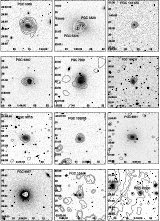 |
Figure 2:
First page of the figure available in electronic form. It presents
the X-ray contours from smoothed X-ray images superimposed onto optical images.
Galaxies are generally at the center of the field. Smoothing is done with a
Gaussian function of
|
| Open with DEXTER | |
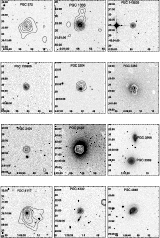 |
Figure 2:
X-ray contours from smoothed X-ray images superimposed onto optical images.
Galaxies are generally at the center of the field. Smoothing is done with a
Gaussian function of
|
| Open with DEXTER | |
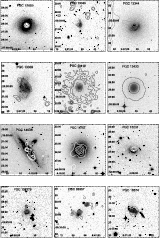 |
Figure 2: continued. |
| Open with DEXTER | |
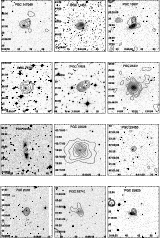 |
Figure 2: continued. |
| Open with DEXTER | |
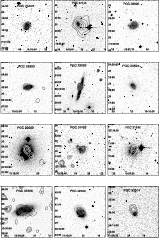 |
Figure 2: continued. |
| Open with DEXTER | |
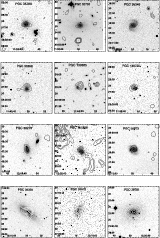 |
Figure 2: continued. |
| Open with DEXTER | |
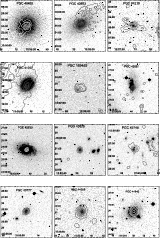 |
Figure 2: continued. |
| Open with DEXTER | |
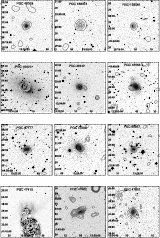 |
Figure 2: continued. |
| Open with DEXTER | |
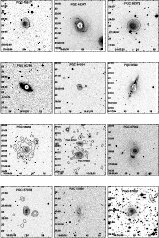 |
Figure 2: continued. |
| Open with DEXTER | |
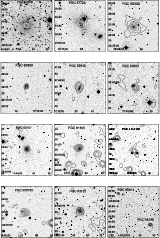 |
Figure 2: continued. |
| Open with DEXTER | |
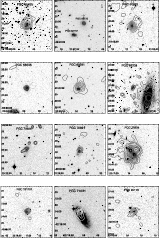 |
Figure 2: continued. |
| Open with DEXTER | |
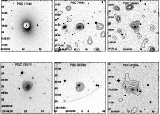 |
Figure 2: continued. |
| Open with DEXTER | |